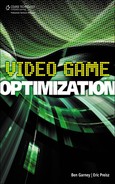0%
20Chapters
0-1Hours read
0kTotal Words
Book Description
Video Game Optimization describes a process for increasing the performance of a video game for better gameplay and visual experience. Very few game developers understand the process of optimizing an entire video game, yet learning the process is surprisingly simple and applicable to a broad audience. The book tackles the process of optimization by first describing how to determine where a game is limited and then providing detailed solutions and examples to solving this limitation. All the examples covered in the book can be applied to a variety of game types and coverage of how to optimize system memory, CPU processing, graphics, and shaders is included.
Table of Contents
- Copyright
- Acknowledgments
- About the Authors
- Introduction
- 1. The Basics of Optimization
- 2. Planning for Your Project
- 3. The Tools
- 4. Hardware Fundamentals
- 5. Holistic Video Game Optimization
- 6. CPU Bound: Memory
- 7. CPU Bound: Compute
- 8. From CPU to GPU
- 9. The GPU
- 10. Shaders
- 11. Networking
- 12. Mass Storage
- 13. Concurrency
- 14. Consoles
- 15. Managed Languages
- 16. GPGPU
